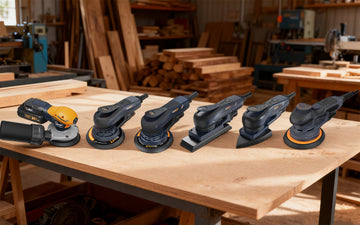Summary: Band saws are machines with continuous blades. They cut wood, metal, and serve special purposes. They excel at curved cuts, resawing, and cutting thick materials that other saws cannot handle. Their versatility and precision make them essential tools in workshops, factories, and industrial sites. They can cut many materials effectively.
Band Saw Basics: Understanding the Machine
What is a Band Saw?
A band saw is a power tool that uses a continuous loop blade (called a "band") stretched between two or more wheels to cut through various materials. The blade is a long, flexible metal strip with teeth along one edge that forms a closed loop, rotating around wheels continuously.
Key characteristics:
- Continuous loop blade design
- Blade moves in one direction only
- Can cut curves, straight lines, and thick materials
- Available in stationary and portable versions
How Does a Bandsaw Work?
A band saw operates through a simple mechanical system:
Basic operation:
- Power source: An electric motor provides the driving force
- Drive system: The motor turns the upper wheel through belts and pulleys
- Blade movement: As the upper wheel rotates, it pulls the continuous blade loop around both wheels
- Cutting action: The blade moves downward through the cutting area, where material is fed into the moving teeth
- Continuous cycle: The blade continues its loop, providing consistent cutting action
Key components in action:
- Upper wheel: Driven by motor, pulls the blade around
- Lower wheel: Acts as an idler, supporting and guiding the blade
- Blade guides: Keep the blade straight and prevent wandering
- Table: Supports the workpiece during cutting
- Tensioning system: Maintains proper blade tightness for effective cutting
The continuous motion and thin blade design allow band saws to make cuts that would be impossible or impractical with other saws. For a safe setup, see OSHA’s machine guarding guidelines

Primary Uses and Applications of Band Saws
The band saw machine is a cutting powerhouse used in many industries. It works well for everything from delicate crafts to heavy industrial tasks. Understanding its uses shows why it's essential.
Woodworking Applications
Band saws excel at cuts that other tools cannot match in precision and thickness capability.
Resawing lumber is the primary application. Professional woodworkers slice 6-8 inch thick boards into thinner pieces, doubling lumber yield for book-matched panels and custom-thickness stock.
Curved cutting showcases unique capabilities. A 1/8-inch blade navigates 1/8-inch radius curves for furniture arcs and decorative elements, which are impossible with circular saws.
Tenon cutting, component shaping, and rough stock preparation benefit furniture making. Many makers use band saws for initial dimensioning before finishing tools.
Thick material processing handles crosscutting and ripping beyond table saw capacity, continuously reducing heat and burning risk in figured woods.
Metalworking Applications
The metalworking industry relies on band saws to cut through thick metal sections cleanly and efficiently. Metal band saw cutting techniques now handle everything from thin sheet metal to large beams.
Industrial fabrication uses include cutting bar stock, angle iron, tubing, and plate materials. A metal band saw cuts continuously, giving a better surface finish than abrasive cutoff saws. This means fewer secondary finishing steps are needed.
Pipe and structural steel cutting is a major application area. Horizontal band saw machines easily cut through 12-inch diameter pipes and beams, making them essential in construction and fabrication shops. For worker safety, see NIOSH’s metalworking guidelines

Specialized Applications
Textile industry applications use special band saws with fine-toothed blades. These saws can cut through several layers of fabric at once. This method ensures consistent patterns and cuts down on cutting time.
Foam cutting and upholstery work benefit from the band saw's ability to create smooth, sealed edges in foam materials. Upholsterers use band saws to cut custom foam shapes for furniture and automotive applications.
Meat processing industry involves cutting large meat pieces into smaller, portion-controlled sizes. Food-grade band saw machines feature stainless steel construction and specialized cleaning systems for sanitary operation.
Types of Band Saws and Their Specific Uses
The band saw machine family includes different types made for specific tasks and workspace needs. Understanding the different types helps determine the optimal choice for various scenarios.
Stationary Band Saws
Vertical Band Saws
The vertical configuration represents the most common band saw machine design in workshops. The blade moves up and down through the workpiece, with the table set horizontally to support the material.
Advantages of vertical band saws:
- Excellent visibility of the cutting line
- Easy material handling and maneuvering
- Versatile blade options from 1/8-inch for intricate work to 1-inch for heavy resawing
- Adjustable table angles for bevel cuts
- Superior dust collection capabilities
Typical applications include woodworking, light metalworking, and general fabrication. The vertical configuration excels at curved cutting, resawing, and general shop work.
Horizontal Band Saws
Horizontal band saws position the blade horizontally. The workpiece is held in a vice, and the saw head moves down to cut.
Benefits of horizontal design:
- Gravity-assisted cutting reduces operator fatigue
- Excellent for cutting long materials like pipe and bar stock
- Superior clamping systems for round and irregular shapes
- Automatic feed capabilities for production work
- Better chip and coolant management for metal cutting
Primary uses focus on metalworking applications, including cutting structural steel, pipe, and bar stock in production environments.
Portable Band Saws
Portable units offer mobility for job sites and places where fixed tools aren't feasible. These handheld or mobile units maintain the benefits of a continuous blade while providing amazing mobility.
Job site applications include cutting conduit, pipe, and structural materials in place. Electricians use portable band saws for precise conduit cuts, while plumbers rely on them for pipe cutting in tight spaces.
Mobility benefits:
- No need to bring materials to the tool
- Battery-powered options eliminate electrical requirements
- Lightweight designs reduce operator fatigue
- Quick setup and breakdown for job efficiency
Specialized portable applications include automotive repair for exhaust system work and maintenance tasks at industrial facilities.
Read this interesting blog about: How To Use A Band Saw?
Band Saw vs. Other Cutting Tools
Understanding when to choose a band saw machine over other cutting tools maximizes efficiency and results. The bandsaw is great for specific tasks where other tools struggle.
Cut-off saw vs. band saw is a common decision point in metal fabrication. Cutoff saws (chop saws) use abrasive wheels or circular blades, while band saw machines use continuous loop blades.
Key differences:
- Cut quality: Band saws produce smoother cuts with minimal heat-affected zones
- Material waste: Band saw kerfs are typically narrower, reducing waste
- Blade life: Band saw blades last significantly longer than abrasive wheels
- Versatility: Band saws handle varied material thicknesses better
When to choose a band saw over circular saws: The decision often comes down to cut complexity and material thickness. A band saw can handle tasks that circular saws can't. It cuts thick materials over 3 inches, makes curved cuts, and minimizes heat generation.
Practical Guide: Using a Band Saw Effectively
Effective bandsaw use requires understanding basic setup procedures and advanced techniques that maximize the machine's potential. Proper bandsaw techniques ensure safety, accuracy, and optimal application results.
Getting Started
Choosing the correct blade is fundamental to achieving quality cuts and maximizing blade life. Blade selection depends primarily on material type and thickness.
Wood Cutting Blades:
- 3-6 TPI: Thick lumber (over 2 inches), rough cutting, fast material removal
- 6-10 TPI: General woodworking, furniture components, medium-thickness stock
- 10-14 TPI: Thin materials, plywood, veneers, detailed work
Metal Cutting Blades:
- 14-18 TPI: Thick metal sections, structural steel, heavy fabrication work
- 18-24 TPI: General metalwork, medium-gauge materials, most shop applications
- 24-32 TPI: Thin sheet metal, precise cuts, finishing work
Specialized Material Blades:
undefined 32+ TPI: Plastics, composites, non-ferrous metals requiring smooth finishes
Blade width considerations: Narrow blades (1/8-1/4 inch) are best for tight curves, and wide blades (1/2-1 inch) are best for straight cuts and resawing.
Safety Protocols
Band saw operation requires strict adherence to safety procedures to prevent injury and ensure consistent results.
Essential Personal Protection:
- Safety glasses with side shields (mandatory for all operations)
- Hearing protection when operating for extended periods
- Avoid loose clothing, jewelry, or gloves that could catch the blade

Operational Safety Rules:
- Maintain safe hand position: Keep hands at least 6 inches from the blade at all times
- Use push sticks: Required for workpieces smaller than 12 inches or when hands would come within 6 inches of blade
- Proper blade guarding: Ensure upper and lower blade guards are correctly positioned before operation
- Work area maintenance: Keep the cutting area clean and free of debris to prevent slipping
- Pre-operation inspection: Check blade tension, tracking, and guide adjustment before each use
Emergency Procedures:
- Know the location of emergency stop switches
- Never attempt to stop the blade by hand
- Allow the blade to come to a complete stop before making adjustments
Frequently Asked Questions
What's the difference between a 14-inch and 18-inch band saw, and which should I choose?
The measurement refers to throat capacity—the distance from the blade to the vertical frame. A 14-inch saw can cut up to 14 inches wide, while an 18-inch saw handles wider materials. Choose based on your typical project sizes: 14-inch suits most hobbyists and small shops, while 18-inch serves furniture makers and professionals working with large stock.
Can I use the same band saw for both wood and metal cutting?
Yes, but you'll need different blades and often speed adjustments. Wood cutting typically requires 3000+ FPM (feet per minute), while metal needs 100-300 FPM. Some band saws have variable speed drives; others require pulley changes. Consider dedicated machines if you frequently switch between materials.
Conclusion
A quality bandsaw is a smart investment for both professionals and hobbyists. It offers versatility and precision and boosts long-term productivity. When you think about your cutting tool needs, remember that a bandsaw is excellent for precision and versatility. The best place to buy a band saw is from Hyperfit, which offers a great collection of tools at amazing prices.




